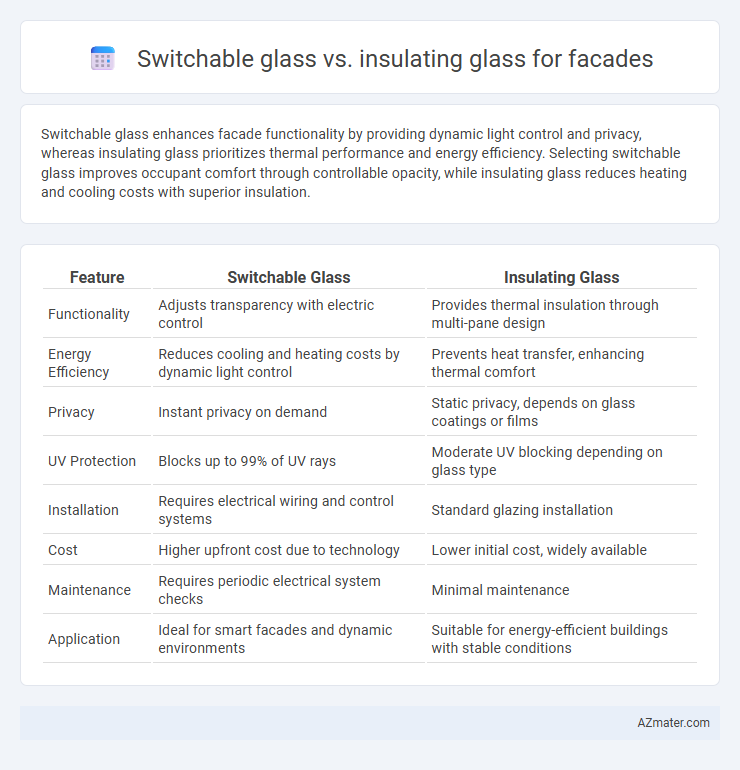Switchable glass enhances facade functionality by providing dynamic light control and privacy, whereas insulating glass prioritizes thermal performance and energy efficiency. Selecting switchable glass improves occupant comfort through controllable opacity, while insulating glass reduces heating and cooling costs with superior insulation.
Table of Comparison
| Feature | Switchable Glass | Insulating Glass |
|---|---|---|
| Functionality | Adjusts transparency with electric control | Provides thermal insulation through multi-pane design |
| Energy Efficiency | Reduces cooling and heating costs by dynamic light control | Prevents heat transfer, enhancing thermal comfort |
| Privacy | Instant privacy on demand | Static privacy, depends on glass coatings or films |
| UV Protection | Blocks up to 99% of UV rays | Moderate UV blocking depending on glass type |
| Installation | Requires electrical wiring and control systems | Standard glazing installation |
| Cost | Higher upfront cost due to technology | Lower initial cost, widely available |
| Maintenance | Requires periodic electrical system checks | Minimal maintenance |
| Application | Ideal for smart facades and dynamic environments | Suitable for energy-efficient buildings with stable conditions |
Introduction to Facade Glass Technologies
Switchable glass and insulating glass represent advanced facade glass technologies enhancing building aesthetics and energy efficiency. Switchable glass offers dynamic control of light and privacy by changing opacity through electrical activation, while insulating glass provides thermal insulation with multiple glass layers separated by gas-filled spaces to reduce heat transfer. Both technologies contribute to sustainable building design by optimizing natural light, improving thermal performance, and reducing energy consumption.
What is Switchable Glass?
Switchable glass, also known as smart glass or electrochromic glass, changes its transparency or opacity when an electric voltage is applied, offering dynamic control over light and privacy in building facades. Unlike insulating glass, which primarily provides thermal insulation through double or triple glazing with air or gas-filled spaces, switchable glass enhances energy efficiency by reducing solar heat gain and glare while allowing users to customize daylight penetration. This innovative technology integrates seamlessly into modern facades, balancing aesthetic flexibility with environmental performance.
What is Insulating Glass?
Insulating glass, also known as double glazing, consists of two or more glass panes separated by a spacer filled with air or inert gas, enhancing thermal insulation and reducing energy loss in facades. It improves building energy efficiency by minimizing heat transfer, controlling condensation, and providing sound insulation, which is essential for climate control and occupant comfort. Switchable glass offers dynamic transparency and privacy modulation but lacks the primary thermal and acoustic performance advantages inherent to insulating glass units.
Key Differences: Switchable vs Insulating Glass
Switchable glass uses electrochromic or liquid crystal technology to control light and privacy by changing transparency on demand, while insulating glass consists of two or more glass panes separated by a spacer filled with air or gas to improve thermal insulation. Switchable glass primarily enhances daylight management and privacy without compromising design aesthetics, whereas insulating glass focuses on reducing heat transfer to improve energy efficiency. The choice depends on whether dynamic light control or superior thermal insulation is the primary requirement for a facade application.
Energy Efficiency Comparison
Switchable glass offers dynamic control over solar heat gain and daylight transmission, significantly reducing cooling loads by adjusting transparency in response to sunlight intensity. Insulating glass, composed of sealed multiple panes with inert gas fills, minimizes heat transfer through improved thermal resistance, lowering heating and cooling energy consumption. Energy modeling indicates switchable glass can reduce HVAC energy use by up to 25% in climates with high solar exposure, whereas insulating glass primarily improves insulation performance, cutting overall energy loss by approximately 15-20%.
Visual and Aesthetic Impacts
Switchable glass offers dynamic visual control by instantly changing from transparent to opaque, enhancing facade aesthetics with privacy and light modulation without bulky shading devices. Insulating glass provides consistent clarity and high thermal performance, maintaining the facade's sleek appearance while minimizing energy loss through multi-pane construction. Both options significantly influence daylight penetration and exterior appearance, but switchable glass adds a transformative visual element that insulating glass cannot achieve.
Smart Functionality and User Control
Switchable glass offers dynamic opacity control, allowing users to adjust transparency via electrical signals, enhancing privacy and daylight management in facades. Insulating glass primarily improves thermal performance by reducing heat transfer through multiple sealed panes, but lacks interactive smart functionality. Smart control in switchable glass empowers real-time environment adaptation, while insulating glass relies on fixed energy-efficient properties without user-driven modulation.
Cost Considerations and ROI
Switchable glass typically incurs higher upfront costs compared to insulating glass due to advanced technology and installation requirements, impacting the initial investment for a facade. Insulating glass offers lower installation expenses and energy savings, contributing to a more predictable and faster return on investment (ROI) through reduced heating and cooling costs. The ROI of switchable glass improves in premium applications where privacy control and dynamic light management justify the premium, whereas insulating glass maximizes cost efficiency in standard facade scenarios.
Suitability for Different Building Types
Switchable glass offers dynamic privacy and light control, making it ideal for commercial buildings like offices and conference rooms where adaptable transparency is crucial. Insulating glass excels in energy efficiency and thermal insulation, suited for residential and high-rise buildings aiming to minimize heating and cooling costs. Both glazing options contribute to sustainable design but differ in application based on building function and occupant requirements.
Future Trends in Facade Glass Innovation
Switchable glass and insulating glass are pivotal in advancing facade technology, with future trends highlighting enhanced energy efficiency through smart glazing solutions. Innovations focus on integrating switchable glass that dynamically controls light and heat transmission, reducing reliance on HVAC systems and optimizing occupant comfort. Insulating glass advancements emphasize multi-layer coatings and vacuum technologies to further improve thermal performance, aligning with sustainability goals in modern architectural design.

Infographic: Switchable glass vs Insulating glass for Facade
 azmater.com
azmater.com